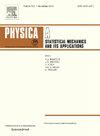Global balance and systemic risk in financial correlation networks
IF 3.1
3区 物理与天体物理
Q2 PHYSICS, MULTIDISCIPLINARY
Physica A: Statistical Mechanics and its Applications
Pub Date : 2025-06-03
DOI:10.1016/j.physa.2025.130698
引用次数: 0
Abstract
The global balance index is used in the network literature to quantify how balanced a signed network is. In this paper we show that the global balance index of financial correlation networks can be used as a systemic risk measure. We define the global balance index of a network starting from a diffusive process that describes how the information spreads across nodes in a network, providing an alternative derivation to the usual combinatorial one. The steady state of this process is the solution of a linear system governed by the exponential of the replication matrix of the process. We provide a bridge between the numerical stability of this linear system, measured by the condition number in an opportune norm, and the structural predictability of the underlying signed network. The link between the condition number and related systemic risk measures, such as the market rank indicators, allows the global balance index to be interpreted as a new systemic risk measure. A comprehensive empirical application to real financial data finally confirms that the global balance index of financial correlation networks represents a valuable and effective systemic risk indicator.
金融关联网络中的全球平衡与系统性风险
网络文献中使用全局平衡指数来量化一个签名网络的平衡程度。本文证明了金融相关网络的全局平衡指数可以作为一种系统风险度量。我们从描述信息如何在网络中跨节点传播的扩散过程开始定义网络的全局平衡指数,为通常的组合推导提供了另一种推导。该过程的稳态是由该过程的复制矩阵的指数控制的线性系统的解。我们在这个线性系统的数值稳定性(由适当范数中的条件数测量)和底层有符号网络的结构可预测性之间提供了一座桥梁。条件数与相关的系统性风险指标(如市场排名指标)之间的联系,使得全球平衡指数可以被解释为一种新的系统性风险指标。通过对真实金融数据的综合实证应用,最终证实了金融关联网络全局平衡指数是一种有价值且有效的系统性风险指标。
本文章由计算机程序翻译,如有差异,请以英文原文为准。
求助全文
约1分钟内获得全文
求助全文
来源期刊
CiteScore
7.20
自引率
9.10%
发文量
852
审稿时长
6.6 months
期刊介绍:
Physica A: Statistical Mechanics and its Applications
Recognized by the European Physical Society
Physica A publishes research in the field of statistical mechanics and its applications.
Statistical mechanics sets out to explain the behaviour of macroscopic systems by studying the statistical properties of their microscopic constituents.
Applications of the techniques of statistical mechanics are widespread, and include: applications to physical systems such as solids, liquids and gases; applications to chemical and biological systems (colloids, interfaces, complex fluids, polymers and biopolymers, cell physics); and other interdisciplinary applications to for instance biological, economical and sociological systems.

 求助内容:
求助内容: 应助结果提醒方式:
应助结果提醒方式:


